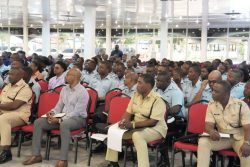The Guyana Elections Commission (GECOM) at an extraordinary meeting on Friday decided to post for public scrutiny the names of the approximately 20,000 new registrants recorded during the aborted House to House Registration exercise (HtH).
While the exercise recorded just over 370,000 entries, fingerprint cross-matching as well as a manual examination by GECOM’s Secretariat found that approximately 350,000 of those entries were already on the National Register of Registrants (NRR).
Usually reliable sources have explained to Sunday Stabroek that the decision to publicly post the 20,000 new registrants was one of three decisions made when the commission met on Friday. The other decisions were that the names of the new registrants would be provided to “stakeholders,” such as political parties, so that they could engage in their own verification and that each registration officer in the presence of party scrutineers would engage in a “desk review” of the list to ensure that those person are not entered into the NRR.
The commission appears to have dismissed outright a recommendation from the People’s Progressive Party/Civic (PPP/C) to allow for a “joint verification exercise” of any new registrants.
It remains unclear when this process will begin and/or end as well as what legal guidelines will direct the activities.
This newspaper has attempted to contact GECOM Chairman retired Justice Claudette Singh, Chief Elections Officer Keith Lowenfield, Public Relations Officer Yolanda Ward and the six other members of the commission for comment to no avail. Up to press time, both commissioners Bibi Shadick and Desmond Trotman declined to comment on the decisions emanating from the meeting, while the others could not be reached.
Opposition leader Bharrat Jagdeo had committed to allowing any new names registered during HtH onto the NRR and the Official List of Electors (OLE) without objection if GECOM allows for a process where scrutineers in the presence of GECOM staff were to visit and verify each name.
Sunday Stabroek has been told that the Secretariat indicated that it would take approximately three weeks to conduct a sample verification process of 15 per cent of new registrants and that a full verification would not be possible within the timeline of a March 2, 2020 elections.
Opposition parliamentarian Anil Nandlall, in a statement to the press on Friday, vehemently objected to this position and stressed that the law mandates that not a single name must eventuate on to the OLE without verification.
“GECOM has an unconditional duty to ensure compliance with this legal requirement. Nothing short will suffice,” Nandlall stressed.
According to the former Attorney General, GECOM was prepared to do a verification by using a 10 per cent random sample but the PPP/C objected on the grounds that even if 80 per cent of the sampling proved accurate, it would allow for 20 per cent of unverified data to eventually reach the OLE.
“That would amount to 4,000 persons in the current circumstances, which is almost a seat at the elections. The PPP insisted on 100% verification which can be completed in a few days. After all, over 370,000 persons were allegedly registered in just over three weeks,” he noted.
Nandlall reminded that the PPP/C had rejected the use of any data generated because of the manner in which it was compiled, that it was never subjected to any form of public scrutiny, including the Claims and Objections exercise, and that it was riddled with factual inaccuracies, such as, that persons could not have been found at addresses stated and persons at those addresses are unaware of the identities of some of these persons, misspelling of names and erroneous biographic data. He claimed that government-nominated commissioners may not want a 100 per cent verification exercise because if this data is padded and fraudulent then the verification exercise will unmask it.
Another concern raised is that this process and any treatment of the HtH data falls outside of the provisions of Guyana’s elections law.
“What happens if a party scrutineer finds someone on the list who is ineligible to be registered? This is not the claims and objections exercise, there is no legal provision for what’s next in such a scenario,” a source indicated.
The HtH exercise was truncated in August after the High Court ruled that it could not be used to remove names from the NRR.
The treatment of the data collected during the nearly month and a half process has engaged the commission for months. A decision had previously been taken to publish for public scrutiny the entire list but no directive legal or otherwise accompanied this publication so the public remained unaware of how to treat with the information.
Concurrently, the names had been sent to a foreign contractor for fingerprint cross-matching with the current NRR as a step to possibly consolidating the data into one list.
Jagdeo has shared that the HtH exercise appears to have registered just under 20,000 additional persons who are eligible to vote. He explained that of the 370,000 persons registered during HtH, 305,000 were identified as entries on the National Register of Registrants Database (NRRD) via the recently completed fingerprint cross-matching exercise.
The remaining 65,000 were believed to be new registrants of whom 37,300 were over the age of 18 but an exercise by the GECOM Secretariat using the first, middle and last names of these individuals found that 17,000 were actually on the Preliminary List of Electors (PLE).
“Of the 20,000 some have re-registered during the claims and objections process so now GECOM is manually comparing the PLE and HtH lists,” Jagdeo noted at a press conference two weeks ago.









